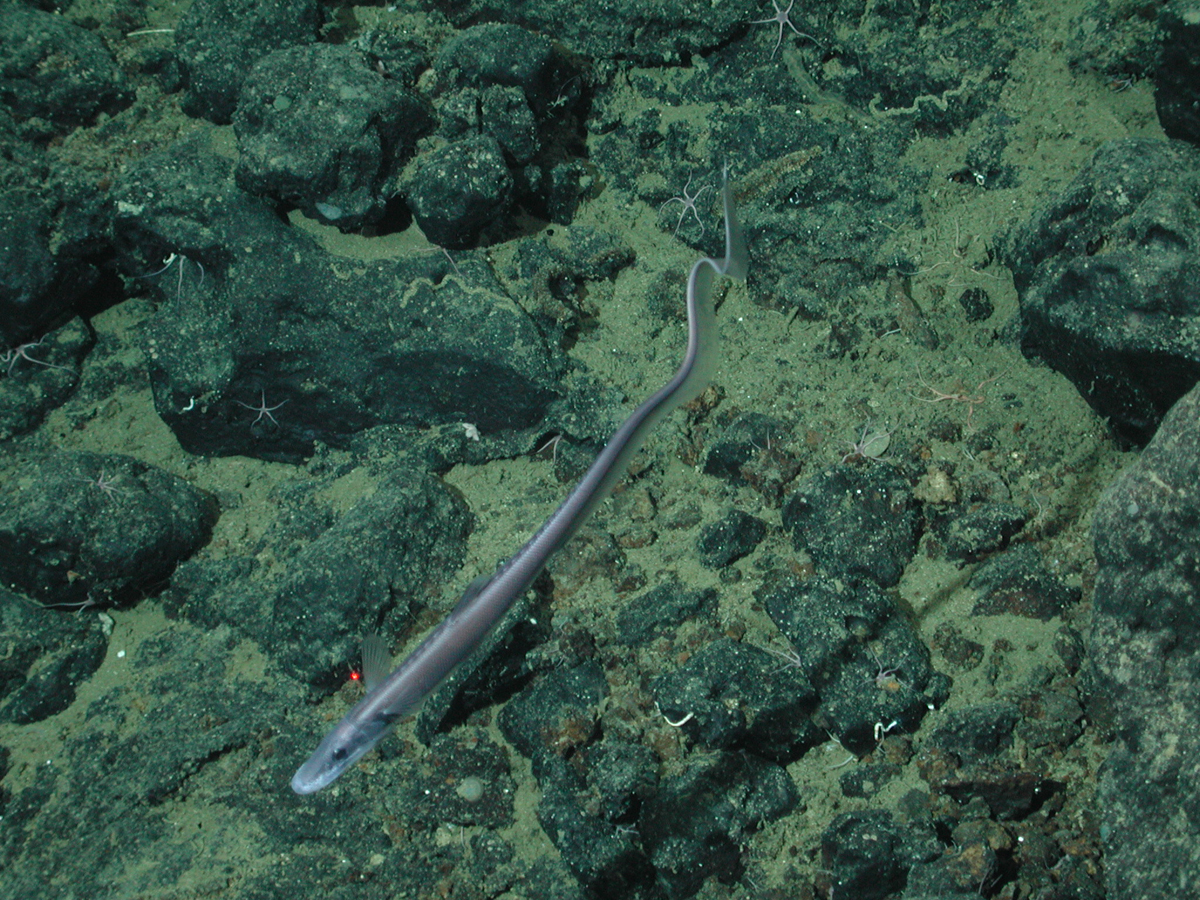- Halosaur
Taxobox
name = Halosaurs

image_caption = "Aldrovandia sp."
image_width = 250px
regnum =Animal ia
phylum = Chordata
classis =Actinopterygii
ordo =Notacanthiformes
familia = Halosauridae
subdivision_ranks = Genera
subdivision = "Aldrovandia " "Halosauropsis " "Halosaurus " See text for species.Halosaurs are
eel -shapedfish es found only at great ocean depths. As the family Halosauridae, halosaurs are one of two families within the orderNotacanthiformes ; the other being thedeep-sea spiny eel s. Halosaurs are thought to have a worldwide distribution, with some seventeen species in three genera represented. Only a handful of specimens have been observed alive, all via chance encounters with remotely operated submersibles.From the Greek "hals" meaning "sea" and "sauros" meaning "
lizard ", halosaurs look like living fossils from some throwback era. Their greatly elongated bodies end in a whip-like tail; their scales are large. There is one small dorsal fin close to the sharply pointed, mostly scaleless head. The tail fin is greatly reduced, with the anal fin being the largest fin. Their pecotral fins are slender and also greatly elongated. The mouth is somewhat large, with the lower jaw shorter than the upper jaw. Thegas bladder is absent.The largest species, the 90 centimetre long
abyssal halosaur ("Halosauropsis macrochir") is also one of the most deep-living fish, recorded at depths of 3,300 metres. Halosaurs have developed certain adaptations to life at these extreme depths, where no light penetrates. Theirlateral line system is highly developed; this is a system ofpore s running the length of the fish's body, lending it a sort of "sixth sense" by detecting nearby vibrations. Some species are also known to hold their elongate pectorals erect and forward, possibly providing a further means of detection.Halosaurs are
benthic fish, spending their time cruising over or resting on the sea floor where temperatures may be just 2-4 degreesCelsius . They propel themselves with rhythmic undulations of the body, not unlikesnake s. Halosaurs are thought to prey mainly on benthicinvertebrate s, such aspolychaete worms,echinoderm s andcrustacea ns such ascopepod s.In life, most halosaurs are a grey to bluish black in colour. Like other notacanthiform fish, halosaurs are able to regenerate their tails easily if lost. This adaptation can be likened to certain terrestrial
reptile s such as theglass lizard , which sacrifices its tail in order to evade predators.Species
There are seventeen species in three genera:
* Genus "Aldrovandia "
**Gilbert's halosaur , "Aldrovandia affinis " (Günther, 1877).
** "Aldrovandia gracilis " Goode & Bean, 1896.
** "Aldrovandia mediorostris " (Günther, 1887).
** "Aldrovandia oleosa " Sulak, 1977.
**Hawaiian halosaur , "Aldrovandia phalacra " (Vaillant, 1888).
** "Aldrovandia rostrata " (Günther, 1878).
* Genus "Halosauropsis "
**Abyssal halosaur , "Halosauropsis macrochir " (Günther, 1878).
* Genus "Halosaurus "
** "Halosaurus attenuatus " Garman, 1899.
** "Halosaurus carinicauda " (Alcock, 1889).
** "Halosaurus guentheri " Goode & Bean, 1896.
** "Halosaurus johnsonianus " Vaillant, 1888.
** "Halosaurus ovenii " Johnson, 1864.
** "Halosaurus parvipennis " Alcock, 1892.
**Goanna fish , "Halosaurus pectoralis " McCulloch, 1926.
** "Halosaurus radiatus " Garman, 1899.
** "Halosaurus ridgwayi " (Fowler, 1934).
** "Halosaurus sinensis " Abe, 1974.References
*
External links
* [http://oceanexplorer.noaa.gov/explorations/02davidson/logs/may21/media/eels_video.html Video footage of a halosaur from NOAA's Ocean Explorer]
Wikimedia Foundation. 2010.
